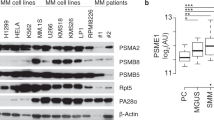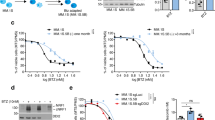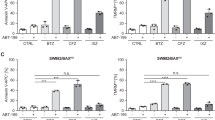Abstract
Resistance towards the proteasome inhibitor bortezomib is poorly understood. We adapted the HL-60, ARH-77 and AMO-1 cell lines (myeloid leukemia, plasmocytoid lymphoma, myeloma) to bortezomib exceeding therapeutic plasma levels, and compared characteristics of the ubiquitin–proteasome system, alternative proteases and the unfolded protein response (UPR) between adapted cells and parental lines. Adapted cells showed increased transcription rates, activities and polypeptide levels of the bortezomib-sensitive β5, but also of the β2 proteasome subunit and consistently retained elevated levels of active β1/β5-type proteasome subunits in the presence of therapeutic levels of bortezomib. Bortezomib-adapted HL-60 cells showed increased expression and proteasome association of the 11S proteasome activator, and did not accumulate poly-ubiquitinated protein, activate the UPR or UPR-mediated apoptosis in response to bortezomib. The rate of protein biosynthesis was reduced, and the transcription of chaperone genes downmodulated. We did not observe major changes in the activities of TPPII, cathepsins or deubiquitinating proteases. We conclude that different types of bortezomib-adapted cell lines, including myeloma, show similar patterns of changes in the proteasomal machinery which result in residual proteasome activity in the presence of bortezomib and a quantitative balance between protein biosynthesis and destruction.
This is a preview of subscription content, access via your institution
Access options
Subscribe to this journal
Receive 12 print issues and online access
$259.00 per year
only $21.58 per issue
Buy this article
- Purchase on Springer Link
- Instant access to full article PDF
Prices may be subject to local taxes which are calculated during checkout





Similar content being viewed by others
References
Richardson PG, Mitsiades C, Hideshima T, Anderson KC . Proteasome inhibition in the treatment of cancer. Cell Cycle 2005; 4: 290–296.
Stapnes C, Doskeland AP, Hatfield K, Ersvaer E, Ryningen A, Lorens JB et al. The proteasome inhibitors bortezomib and PR-171 have antiproliferative and proapoptotic effects on primary human acute myeloid leukaemia cells. Br J Haematol 2007; 136: 814–828.
Strauss SJ, Higginbottom K, Juliger S, Maharaj L, Allen P, Schenkein D et al. The proteasome inhibitor bortezomib acts independently of p53 and induces cell death via apoptosis and mitotic catastrophe in B-cell lymphoma cell lines. Cancer Res 2007; 67: 2783–2790.
Orlowski RZ, Kuhn DJ . Proteasome inhibitors in cancer therapy: lessons from the first decade. Clin Cancer Res 2008; 14: 1649–1657.
Glickman MH, Ciechanover A . The ubiquitin-proteasome proteolytic pathway: destruction for the sake of construction. Physiol Rev 2002; 82: 373–428.
Heinemeyer W, Ramos PC, Dohmen RJ . The ultimate nanoscale mincer: assembly, structure and active sites of the 20S proteasome core. Cell Mol Life Sci 2004; 61: 1562–1578.
Bogyo M, McMaster JS, Gaczynska M, Tortorella D, Goldberg AL, Ploegh H . Covalent modification of the active site threonine of proteasomal beta subunits and the Escherichia coli homolog HslV by a new class of inhibitors. Proc Natl Acad Sci USA 1997; 94: 6629–6634.
Ardley HC, Robinson PA . E3 ubiquitin ligases. Essays Biochem 2005; 41: 15–30.
Amerik AY, Hochstrasser M . Mechanism and function of deubiquitinating enzymes. Biochim Biophys Acta 2004; 1695: 189–207.
Ovaa H, Kessler BM, Rolen U, Galardy PJ, Ploegh HL, Masucci MG . Activity-based ubiquitin-specific protease (USP) profiling of virus-infected and malignant human cells. Proc Natl Acad Sci USA 2004; 101: 2253–2258.
Meusser B, Hirsch C, Jarosch E, Sommer T . ERAD: the long road to destruction. Nat Cell Biol 2005; 7: 766–772.
Zhang K, Kaufman RJ . The unfolded protein response: a stress signaling pathway critical for health and disease. Neurology 2006; 66: S102–S109.
Hitomi J, Katayama T, Eguchi Y, Kudo T, Taniguchi M, Koyama Y et al. Involvement of caspase-4 in endoplasmic reticulum stress-induced apoptosis and Aβ-induced cell death. J Cell Biol 2004; 165: 347–356.
Obeng EA, Carlson LM, Gutman DM, Harrington Jr WJ, Lee KP, Boise LH . Proteasome inhibitors induce a terminal unfolded protein response in multiple myeloma cells. Blood 2006; 107: 4907–4916.
Glas R, Bogyo M, McMaster JS, Gaczynska M, Ploegh HL . A proteolytic system that compensates for loss of proteasome function. Nature 1998; 392: 618–622.
Princiotta MF, Schubert U, Chen W, Bennink JR, Myung J, Crews CM et al. Cells adapted to the proteasome inhibitor 4-hydroxy-5-iodo-3-nitrophenylacetyl-Leu-Leu-leucinal-vinyl sulfone require enzymatically active proteasomes for continued survival. Proc Natl Acad Sci USA 2001; 98: 513–518.
Turk V, Turk B, Turk D . Lysosomal cysteine proteases: facts and opportunities. EMBO J 2001; 20: 4629–4633.
Berkers CR, Verdoes M, Lichtman E, Fiebiger E, Kessler BM, Anderson KC et al. Activity probe for in vivo profiling of the specificity of proteasome inhibitor bortezomib. Nat Methods 2005; 2: 357–362.
Verdoes M, Florea BI, Menendez-Benito V, Maynard CJ, Witte MD, van der Linden WA et al. A fluorescent broad-spectrum proteasome inhibitor for labeling proteasomes in vitro and in vivo. Chem Biol 2006; 13: 1217–1226.
Kraus M, Rückrich T, Reich M, Gogel J, Beck A, Kammer W et al. Activity patterns of proteasome subunits reflect bortezomib sensitivity of hematologic malignancies and are variable in primary human leukemia cells. Leukemia 2007; 21: 84–92.
Oerlemans R, Franke NE, Assaraf YG, Cloos J, van Zantwijk I, Berkers CR et al. Molecular basis of bortezomib resistance: proteasome subunit beta5 (PSMB5) gene mutation and overexpression of PSMB5 protein. Blood 2008; 112: 2489–2499.
Lü S, Chen Z, Yang J, Chen L, Gong S, Zhou H et al. Overexpression of the PSMB5 gene contributes to bortezomib resistance in T-lymphoblastic lymphoma/leukemia cells derived from Jurkat line. Exp Hematol 2008; 36: 1278–1284.
Lü S, Yang J, Song X, Gong S, Zhou H, Guo L et al. Point mutation of the proteasome beta5 subunit gene is an important mechanism of bortezomib resistance in bortezomib-selected variants of Jurkat T cell lymphoblastic lymphoma/leukemia line. J Pharmacol Exp Ther 2008; 326: 423–431.
Fuchs D, Berges C, Opelz G, Daniel V, Naujokat C . Increased expression and altered subunit composition of proteasomes induced by continuous proteasome inhibition establish apoptosis resistance and hyperproliferation of Burkitt lymphoma cells. J Cell Biochem 2008; 103: 270–283.
Wang EW, Kessler BM, Borodovsky A, Cravatt BF, Bogyo M, Ploegh HL et al. Integration of the ubiquitin-proteasome pathway with a cytosolic oligopeptidase activity. Proc Natl Acad Sci USA 2000; 97: 9990–9995.
Kraus M, Malenke E, Gogel J, Müller H, Rückrich T, Overkleeft H et al. Ritonavir induces ER-stress and sensitizes sarcoma cells towards bortezomib-induced apoptosis. Mol Cancer Ther 2008; 7: 1940–1948.
Acknowledgements
We thank the Proteom-Centrum at the Interfaculty Institute for Cell Biology, University of Tübingen (Professor A Nordheim) for use of the fluorescence scanner and Carsten Henneges for help with data analysis. Research was supported by grants from Deutsche Forschungsgemeinschaft (SFB685), the Deutsche Krebshilfe and the Swiss National Science Foundation (to CD) as well as the Clinical Trials Unit at the Cantonal Hospital St Gallen (CTU-KSSG).
Author information
Authors and Affiliations
Corresponding author
Additional information
Supplementary Information accompanies the paper on the Leukemia website (http://www.nature.com/leu)
Supplementary information
Rights and permissions
About this article
Cite this article
Rückrich, T., Kraus, M., Gogel, J. et al. Characterization of the ubiquitin–proteasome system in bortezomib-adapted cells. Leukemia 23, 1098–1105 (2009). https://doi.org/10.1038/leu.2009.8
Received:
Revised:
Accepted:
Published:
Issue Date:
DOI: https://doi.org/10.1038/leu.2009.8
Keywords
This article is cited by
-
Ex vivo drug response heterogeneity reveals personalized therapeutic strategies for patients with multiple myeloma
Nature Cancer (2023)
-
A drug repurposing strategy for overcoming human multiple myeloma resistance to standard-of-care treatment
Cell Death & Disease (2022)
-
A clinically relevant pulse treatment generates a bortezomib-resistant myeloma cell line that lacks proteasome mutations and is sensitive to Bcl-2 inhibitor venetoclax
Scientific Reports (2022)
-
POH1/Rpn11/PSMD14: a journey from basic research in fission yeast to a prognostic marker and a druggable target in cancer cells
British Journal of Cancer (2022)
-
Borax Pentahydrate and Disodium Pentaborate Decahydrate Are Candidates as Anti-leukemic Drug Components by Inducing Apoptosis and Changing Bax/Bcl-2 Ratio in HL-60 Cell Line
Biological Trace Element Research (2022)



